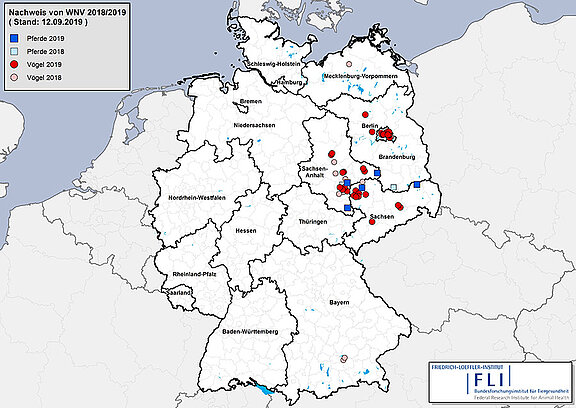Insel Riems, 12. September 2019. From the beginning of July until mid-September 2019, the National Reference Laboratory for infections with West Nile virus (WNV) of the FLI confirmed five cases in horses with central nervous disorders in Saxony and Saxony-Anhalt as well as 37 positive cases in birds, which have been found in the federal states of Berlin, Brandenburg, Saxony-Anhalt and Saxony. Although, in general, only a part of the infected horses show clinical symptoms, vaccination of horses in the currently affected regions is recommended due to the potentially severe clinical course of the disease. The Standing Committee on Vaccination in Veterinary Medicine (StIKo Vet) published a statement on this topic last year already. Futher cases of infection are expected to occur..
Similar to humans, the majority of WNV-infected horses do not develop clinical symptoms. However, some animals present significant central nervous dysfunction due to encephalitis or meningitis. These dysfunctions may include stumbling, paralysis of the hind limbs, ataxia, general weakness, muscle tremor and paralyses up to immobility. The infected horses develop more rarely a feverish general disease, but neurological symptoms prevail. Horses with clinical signs may survive the infection, but up to 20 percent of these animals will suffer irreversible neurological damages. There is no specific treatment available, only symptoms can be treated. The disease is fatal in 22 to 44 percent of the infected animals. In Germany, three inactivated vaccines for horses are licensed and available.
Furthermore, 37 cases in birds have been detected in the above mentioned federal states in the same period. Affected species in wild birds comprise so far blue and great tit, goshawk, sparrow and eagle owl as well as various birds kept in zoos (e. g. Andean flamingo, great grey owl, rainbow lorikeet, Inca tern, Japanese gull, canary, pelican, Javanese pond heron, snowy owl, swift parrot, Chinese merganser). In 2019, significantly more species are affected than in the previous year. In birds, too, further cases of infection are expected to occur.
So far, WNV cases have been found in regions which were already affected last year with the exception of Brandenburg. Thus, we can most probably assume that WNV has successfully overwintered in endemic mosquitoes. Morever, similiar to last year, cases of the closely related Usutu virus occured more frequently in wild birds in the weeks before the first WNV case was found. The epidemic is still going on and, in some regions, has repeatedly led to a high mortality rate, especially in blackbirds. An overview of all cofirmed Usutu cases until the end of August 2019 is available on the NABU website.
WNV is transmitted by bloodsucking mosquitoes. The most important hosts are birds. In rarer cases, transmission to horses and humans may also occur. Infection with WNV in birds and horses is a notifiable animal disease. There is currently no national regulation for the control of this animal disease.


